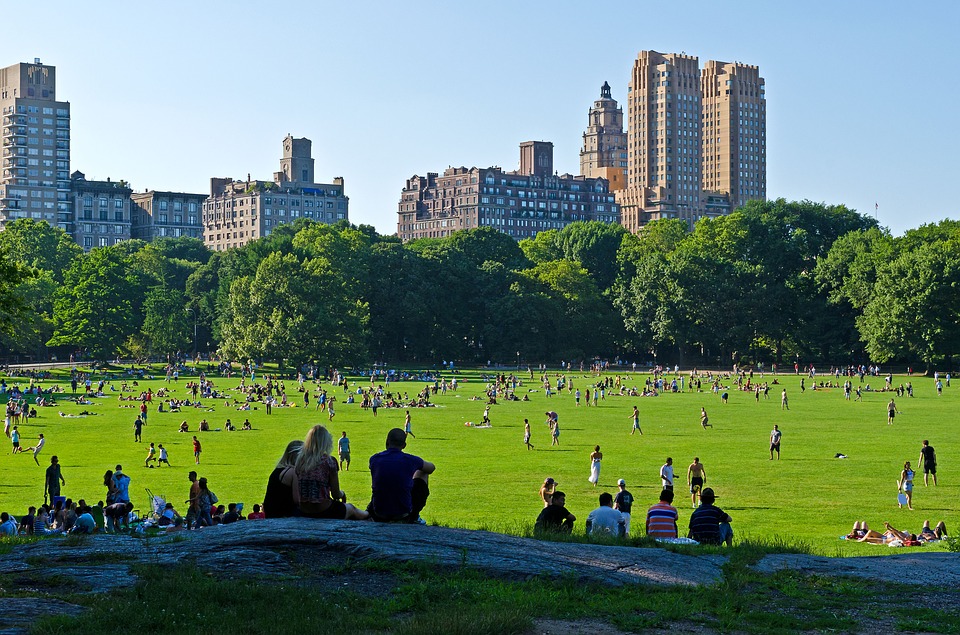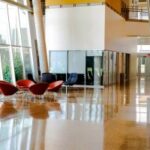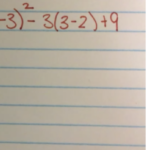
Thanks to Eric Walters, Director of STEM at Marymount School of New York and AP Physics teacher, an AP Physics class in New York created their own walkSTEM tours in New York, during the Covid-19 pandemic. Marymount is an independent, girls school located on the Upper East side of Manhattan. Four groups of students in Mr Walters’ AP Physics class worked together to connect what they learned in the physics classroom to their real world. This post showcases their projects and describes the process they used to create them during the Covid 19 pandemic.
The videos are loaded with great content that connects to physics concepts. Some key physics concepts featured include: Rotational Kinematics, Oscillations, Friction, Free Fall Motion, Tension, Work, Optics, Simple Harmonic Motion and Energy, Thermodynamics, and more.
We asked the students:
What were the most challenging and rewarding parts of the project?
Group 1: The most challenging aspects of designing each stop were coming up with simple questions that were easily understandable for someone without a physics background. It was challenging to come up with concepts and questions that did not overlap when designing our tour as a whole. We enjoyed thinking about common sites in central park in a new way and applying concepts that we have learned this year in physics to these locations.
Group 2: The most challenging aspect of designing each stop was making sure that we were explaining it well enough and simply enough for the viewers; we tried not to use overly complex topics in order to avoid that. For each stop, we thought that the physics concepts that we came up with suited each stop, but finding a good way to move throughout the zoo without walking through the same path was challenging, but we eventually came up with a good route.
Group 3: The most challenging aspects of designing each stop were coming up with simple questions that were easily understandable for someone without a physics background. It was challenging to come up with concepts and questions that did not overlap when designing our tour as a whole. We enjoyed thinking about common sites in Central Park in a new way and applying concepts that we have learned this year in physics to these locations.
Group 4: A challenging aspect of designing each stop was finding physics concepts to fit the stops we had already chosen—especially our freezer stop. We enjoyed collaborating as a team, building and learning from each other’s ideas.
It should be noted that the original plan was for the students to film a live walking tour of themselves at these sites. Each student group selected their walk locations, identified their stops, brainstormed their key physics question, response, and ways they would illustrate relevant concepts at each stop. The plan was to film on location after spring break. Since it was impossible to walk in public in NYC after spring break, given the Coronavirus pandemic, the class chose to adapt the project. The students used Adobe Spark to create their videos instead of on-location filming. We commend their dedication and adaptability. Technology has allowed so many of us to find ways to be together during these unprecedented times and the students used technology so that all of us can join them as they share their STEM mindsets and their ways of looking at particular locations in their home city of New York, using the knowledge they have gained this year in their AP Physics class.
How did you find the change in plan – from the original plan to using software to create your video?
Group 1: It was challenging learning how to use Adobe Spark at first, but we found ways to make it a creative video overall.
Group 2: Shifting to AdobeSpark was definitely a bit of a challenge. Because the program only allowed one person to edit the video at a time, the process was a bit slow. Our group wished we also could have seen our locations in person and gathered our own photos, which probably would have made our walkSTEM tour a bit easier to follow.
Group 3: I think that the process of moving to Adobe Spark was pretty smooth. Although it was difficult to not be able to explain our concepts in a video at the specific site, I think that the final product was still clear and engaging. Our team is proud of the work that we have done and we hope that others are able to enjoy what we have put together.
Group 4: We found Adobe Spark an easy platform to use and work together on. We had to rethink how we could make our project just as engaging for our audiences even though our original plan had been scrapped.
What advice do you have for future students attempting the same project?
Group 1: Be open minded about the possibility of multiple physics concepts in each spot and don’t feel like you can’t change your original plan and adapt as you go along.
Group 2: The advice that I would give students is just to have fun doing it! This should not feel like an assignment but as a good way to recognize physics in the world. Also, I would tell students that if they think it is fun, then the audience will also probably think that it is fun! I would also advise students to have a solid plan before doing anything as the route is very important in how people navigate through the stops.
Group 3: One piece of advice is to pick out a few possibilities for stops to use and focus on one question you want to answer for each stop when brainstorming ideas. This will help you create a more focused and easy to understand walkSTEM.
Group 4: Think about the physics concepts you want to explore before you choose your stops. Make it creative and fun for people to engage in!
What do you hope the major take-away is for your viewers?
Group 1: We want our viewers to think of physics in a whole new way and pay attention to how it is present in their daily lives, and realize that physics does not have to be as complicated as it seems.
Group 2: I would like the viewers to think about the importance of physics in their everyday lives and how it applies to everything around them. While doing the project, I definitely learned a lot about the architecture of the zoo, the animals, and conceptual situations. I hope this video would teach others more about physics and also inspire people to look at their surroundings in a new perspective – one that involves curiosity about STEM and its relevance.
Group 3: We would want viewers to take away the basic concepts we discussed at each stop and to recognize that there are physics concepts all around you. It can be very interesting to look around and think about all the science that happens in our everyday lives.
Group 4: That physics lives in our everyday lives even when we don’t know it!
But how did this project spawn in a New York AP Physics classroom? The students’ teacher, Mr. Walters, took interest in the Create Your Own walkSTEM program in Summer, 2019, and has worked hard to make this a reality for his students. Read on for Mr. Walters’ experience with the project.
Mr. Walters’ Reflection
Finding “good sessions” at a teachers’ conference is always a challenge. Some sessions focus on educational research, some are activity-based while others outline a specific program at a specific school. I prefer sessions where I either leave with an easy-to-implement idea or sessions that spark some creativity in me.
In the spring of 2019, I received information from the College Board announcing the second year of a program: AP with WE Service. As noted on the College Board website, “AP with WE Service combines college-level learning from the Advanced Placement® Program with WE’s service learning model to create an opportunity for AP students to apply their classroom work to the real world. In the AP with WE Service program, students engage in service learning activities to strengthen their understanding of AP course content and skills, using what they’re learning to tackle real-life social issues.”
Enrollment in our AP Physics C: Mechanics was lagging. I was also always seeking opportunities to infuse the school’s mission to educate young women “prepared to challenge, shape, and change the world” into the curriculum. AP with WE Service seemed like a natural fit.
The theme of the 2019 National Coalition of Girls’ Schools’ Annual Conference in Pasadena was Dream, Dare, Do. In searching for a “good session” on Wednesday afternoon, I saw a session entitled “Girls walkSTEM: Strengthening Identity and Broadening Participation in STEM/STEAM” with Brea Ratliff from talkSTEM and Barbara Fishel from Hockaday School in Dallas. I have known Barb for years, and I knew if she was involved in a program, it had to be a good program.
Brea and Barb outlined the talkSTEM program in Dallas and how Hockaday had become involved. Barb showed several student walkSTEM@Hockaday videos that described various STEM concepts around Hockaday. It took approximately two minutes for a lightbulb to go off in my head. Not only was this also a perfect “Marymount” project, it was also a perfect “AP with WE/AP Physics C” project. It was one of the few sessions I attended in Pasadena where I went up to the presenters afterwards and engaged in such a long conversation with Brea and Barb that the next presenter kicked us out.
I connected with Koshi immediately and was surprised to find out that she had a previous Marymount connection: she had done educational research at Marymount almost twenty years ago.
The pathway laid out for us by Koshi and her team was perfect. Students were able to easily outline their tour stops, document the learning that would be taking place at each stop, as well as apply the appropriate physics concepts.
The Covid-19 pandemic threw us for a loop. The students had expected to film their videos throughout their tours. It would have been easy to just chuck the project. But flexibility was the key. The students used (I hope) copyright-free videos and images to describe their locations and we switched platforms to Adobe Spark. That switch required students (and me) to learn a new platform rather quickly. In the end, the students made it to the finish line. Their projects are available on the talkSTEM YouTube channel in the Create Your Own walkSTEM category of playlists.
I’m looking forward to implementing the talkSTEM program next year in both my AP Physics C: Mechanics and my other senior elective, Atmospheric Science.
About Eric Walters
I currently serve as the Director of STEM Education at Marymount School of New York, where I teach Atmospheric Science, AP Physics C: Mechanics, Honors Physics, Videography: Shot on iPhone, and iOS App Development with Swift. As an Apple Distinguished Educator and a Google Certified Educator, I believe that transformative teaching and learning occurs when students (and teachers) construct their own knowledge, collaborate with peers, and represent that knowledge and understanding in ways that are meaningful to the learner, all which receiving authentic, relevant, robust, and holistic feedback.
I currently serve as the Director of STEM Education at Marymount School of New York, where I teach Atmospheric Science, AP Physics C: Mechanics, Honors Physics, Videography: Shot on iPhone, and iOS App Development with Swift. As an Apple Distinguished Educator and a Google Certified Educator, I believe that transformative teaching and learning occurs when students (and teachers) construct their own knowledge, collaborate with peers, and represent that knowledge and understanding in ways that are meaningful to the learner, all which receiving authentic, relevant, robust, and holistic feedback.
I serve as faculty moderator for the Student Tech Team @Marymount, which plans the annual STEMxYouth Summit, a day-long celebration of all things STEMx for high school students in the New York City metropolitan area and coordinates the Student Social Media Team, which provides resources and webinars for faculty, administrators, parents and students on teen social media use from the user perspective. I also moderate CODE, our Upper School Coding Club, which provides coding experiences and learning for faculty and students. CODE also coordinates and runs the National Computer Science Honor Society for Girls, which celebrates the success of high school females in coding (with seven chapters nationwide). I also served as co-Director of the Making and Learning Institute at Marymount, which hosted monthly online conversations and regular, innovative professional development experiences on new paradigms in teaching and learning. As co-Director, I edited and published three books: From Prototype to Pitch, Volumes 1 and 2 as well as Innovative Teaching and Learning: Disrupting the K-12 Classroom. I have also been awarded with the NCWIT Aspirations in Computing Award.


